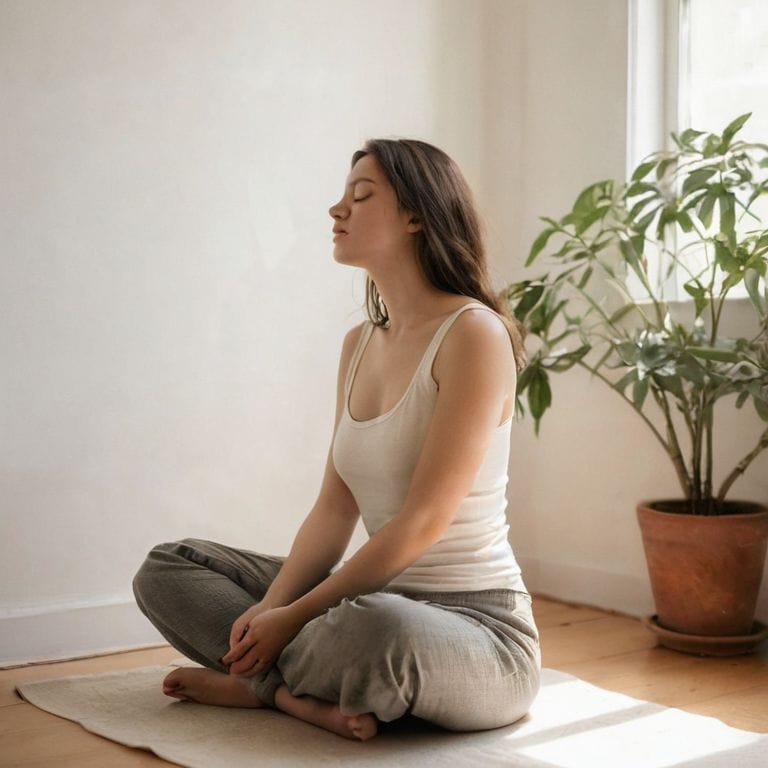Let’s take a deep breath together and explore the gentle art of diaphragmatic breathing. I still remember my first attempts at learning how to do diaphragmatic breathing – it was like trying to grasp a slippery fish, I just couldn’t seem to get it right. But what I’ve come to realize is that the myth that diaphragmatic breathing is only for experienced meditators or yogis is simply not true. In fact, it’s a simple, accessible technique that can be practiced by anyone, anywhere.
As we embark on this journey to discover the simplicity of diaphragmatic breathing, I want to assure you that you’ll find no gimmicks or New Age jargon here. Instead, I’ll offer you practical advice and straightforward guidance on how to do diaphragmatic breathing to calm your mind and soothe your body. In this article, we’ll break down the basics of diaphragmatic breathing, and I’ll share my personal tips for making it a sustainable part of your daily routine. By the end of this guide, you’ll be equipped with the knowledge and confidence to breathe more deeply, live more fully, and find a sense of inner stillness that stays with you long after you’ve finished reading.
Table of Contents
Guide Overview: What You'll Need

Total Time: 10 – 15 minutes
Estimated Cost: $0
Difficulty Level: Easy
Tools Required
- None Just yourself and a quiet space
Supplies & Materials
- None No equipment needed, just a comfortable seated or lying position with your back supported, ideally on a floor or mat that is 6 inches thick
Step-by-Step Instructions
- 1. To begin, find a quiet and comfortable spot to sit or lie down where you can relax your body and focus on your breath. Take a moment to notice the sensation of your feet touching the ground, the sensation of the air on your skin, and the sounds around you.
- 2. Next, place one hand on your belly and the other on your chest, and take a deep breath in through your nose, allowing your diaphragm to drop and your belly to rise as your lungs fill with air. As you breathe in, notice if your chest or belly is moving, and try to isolate the movement to your belly, feeling it expand outward.
- 3. Now, breathe out slowly through your mouth, allowing your diaphragm to rise and your belly to fall as your lungs empty. As you exhale, focus on the sensation of the air leaving your body, and try to release any tension in your muscles, starting from your toes and moving up to the top of your head.
- 4. Continue breathing in and out, focusing on the sensation of your diaphragm moving up and down, and try to establish a natural rhythm. If your mind starts to wander, gently bring your attention back to your breath, without judgment or distraction.
- 5. As you breathe, pay attention to the sensation of the air moving in and out of your nostrils, and try to refine your awareness of the subtle sensations in your body. Notice if there are any areas of tension or relaxation, and allow yourself to let go of any thoughts or worries.
- 6. To deepen your practice, try counting your breaths, inhaling for a count of four and exhaling for a count of four, and focus on the sensation of your diaphragm moving in sync with your count. As you breathe, repeat a gentle phrase to yourself, such as “I am present” or “I am calm,” and allow the words to sink deeply into your mind.
- 7. Finally, as you come to the end of your practice, take a few moments to notice how you feel, and try to carry the sense of calm with you throughout your day. Take one last, deep breath in, and when you are ready, slowly open your eyes, and return to your daily activities with a renewed sense of inner peace.
Unlocking Diaphragmatic Breathing

As we explore the world of diaphragmatic breathing, it’s essential to understand the importance of proper posture. When we sit or stand with our spine aligned, our diaphragm has the space it needs to expand and contract, allowing for a full and deep breath. This, in turn, can lead to a sense of calm and relaxation, making it an excellent technique for anxiety relief. By incorporating diaphragm exercises for beginners into our daily routine, we can start to experience the benefits of deep breathing practices.
To unlock the full potential of diaphragmatic breathing, it’s crucial to focus on mindful breathing. This means paying attention to the sensation of the breath moving in and out of the body, without getting caught up in thoughts or distractions. By doing so, we can start to strengthen our diaphragm muscles, leading to more efficient breathing and a greater sense of overall well-being. Regular practice can also lead to a reduction in stress and anxiety, making it an excellent tool for stress reduction.
As we continue on this journey of diaphragmatic breathing, remember that the key is to be gentle and patient with ourselves. It’s not about forcing the breath or trying to achieve a specific state, but rather about allowing the body to relax and let go. By incorporating exercises to strengthen diaphragm muscles into our practice, we can start to experience the benefits of deep breathing practices and cultivate a sense of inner peace and calm.
Diaphragm Exercises for Beginners
To deepen our practice, let’s explore some diaphragm exercises perfect for beginners. Start by lying on your back, placing one hand on your belly and the other on your chest. Take a deep breath in, allowing your belly to rise as your diaphragm descends. Your hand on your belly should move outward, while your chest remains still.
As you exhale, your belly should fall, and your diaphragm rise. Repeat this process several times, feeling the gentle rise and fall of your belly. This simple exercise helps train your diaphragm to expand and contract, making diaphragmatic breathing more accessible. Remember, patience and consistency are key; start with short practices and gradually increase as you become more comfortable with the sensation.
Proper Posture for Deep Breathing
As we explore the depths of diaphragmatic breathing, let’s take a moment to consider the foundation of our practice: posture. Take a deep breath in, and as you exhale, allow your spine to lengthen, supporting the natural curve of your neck and lower back. Imagine roots growing from the base of your spine, grounding you in stability and calmness.
With your spine aligned, bring your attention to your shoulders, allowing them to relax and drop, releasing any tension or strain. Feel the weight of your body distributed evenly, supported by the earth beneath you. As you breathe, maintain this gentle, open posture, allowing your diaphragm to expand and contract freely, unencumbered by tension or restriction.
Embracing the Rhythm of Life: 5 Essential Tips for Diaphragmatic Breathing
- Let’s start with the foundation: finding a quiet and comfortable space to breathe, free from distractions, where you can gently focus on your breath
- Notice the sensation of your feet touching the ground, feeling the weight and connection to the earth, as you inhale deeply through your nose, allowing your belly to rise
- Practice makes peaceful: commit to a daily breathing practice, even if it’s just a few minutes, to cultivate awareness and calm in your daily life
- Listen to your body: if you feel any discomfort or strain while breathing, gently adjust your posture or pause, remembering that the goal is relaxation and ease
- Be gentle with yourself: diaphragmatic breathing is a journey, not a performance, so allow yourself to explore, learn, and unfold at your own pace, without judgment or expectation
Embracing the Calm: 3 Key Takeaways
Allow your breath to be your anchor, gently bringing you back to the present moment with each inhale and exhale
Remember, proper posture is essential for deep, diaphragmatic breathing – let your body relax and open up to the breath
Practice diaphragmatic breathing regularly, even if just for a few minutes a day, to cultivate a sense of inner stillness and calm that stays with you throughout your day
Embracing the Breath, Embracing Life

As we conclude our journey into the world of diaphragmatic breathing, let’s take a moment to reflect on the simplicity of this powerful practice. We’ve explored the step-by-step process of diaphragmatic breathing, delved into exercises for beginners, and discussed the importance of proper posture for deep breathing. By incorporating these techniques into our daily lives, we can begin to experience a profound sense of calm and clarity. Remember, the key to unlocking diaphragmatic breathing lies in patience and consistency, allowing ourselves to gently let go of tension and embrace the present moment.
As you continue on your path, I invite you to remember that diaphragmatic breathing is not just a technique, but a gateway to inner stillness. It’s a reminder that peace is always available, waiting to be uncovered beneath the surface of our busy lives. May you carry the gentle rhythm of your breath with you, a constant companion on your journey towards greater awareness, compassion, and understanding of yourself and the world around you.
Frequently Asked Questions
How can I tell if I'm using my diaphragm correctly while breathing?
To check if you’re using your diaphragm, place one hand on your belly and the other on your chest. Take a deep breath in, and notice which hand moves. If your belly rises while your chest remains still, you’re breathing with your diaphragm. Let’s try it together, shall we?
Can diaphragmatic breathing be practiced in any position or is it limited to certain postures?
Let’s explore this together. While it’s ideal to practice diaphragmatic breathing in a relaxed, upright position, it’s not limited to one posture. You can breathe diaphragmatically lying down, sitting, or even standing – the key is to release tension and allow your diaphragm to drop, filling your lungs fully. Experiment and find what works for you.
How often should I practice diaphragmatic breathing to experience its full benefits?
Let’s explore the rhythm of practice together. To experience the full benefits of diaphragmatic breathing, I recommend starting with short daily sessions, even just 5-10 minutes, and gradually increasing as you become more comfortable with the practice. Aim to breathe with intention at least 2-3 times a day, allowing the calm to settle within you.
